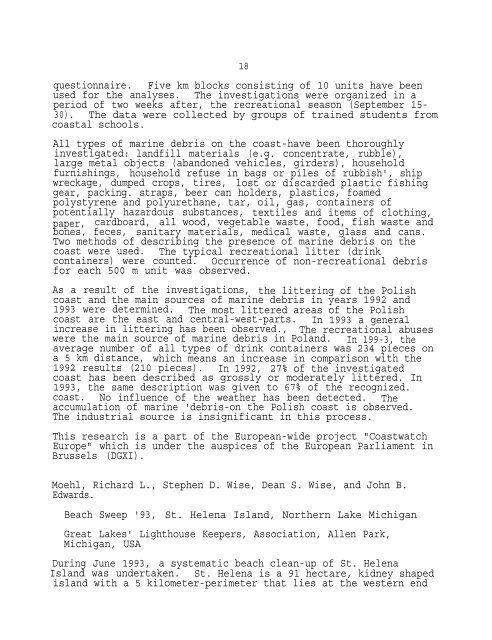Poster abstracts and manuscripts from the Third International ...
Poster abstracts and manuscripts from the Third International ...
Poster abstracts and manuscripts from the Third International ...
You also want an ePaper? Increase the reach of your titles
YUMPU automatically turns print PDFs into web optimized ePapers that Google loves.
18<br />
questionnaire. Five km blocks consisting of 10 units have been<br />
used for <strong>the</strong> analyses. The investigations were organized in a<br />
period of two weeks after, <strong>the</strong> recreational season (September 15-<br />
30). The data were collected by groups of trained students <strong>from</strong><br />
coastal schools.<br />
All types of marine debris on <strong>the</strong> coast-have been thoroughly<br />
investigated: l<strong>and</strong>fill materials (e.g. concentrate, rubble),<br />
large metal objects (ab<strong>and</strong>oned vehicles, girders), household<br />
furnishings, household refuse in bags or piles of rubbish', ship<br />
wreckage, dumped crops, tires, lost or discarded plastic fishing<br />
gear, packing. straps, beer can holders, plastics, foamed<br />
polystyrene <strong>and</strong> polyurethane, tar, oil, gas, containers of<br />
potentially hazardous substances, textiles <strong>and</strong> items of clothing,<br />
paper, cardboard, all wood, vegetable waste, food, fish waste <strong>and</strong><br />
bones, feces, sanitary materials, medical waste, glass <strong>and</strong> cans.<br />
Two methods of describing <strong>the</strong> presence of marine debris on <strong>the</strong><br />
coast were used. The typical recreational litter (drink<br />
containers) were counted. Occurrence of non-recreational debris<br />
for each 500 m unit was observed.<br />
As a result of <strong>the</strong> investigations, <strong>the</strong> littering of <strong>the</strong> Polish<br />
coast <strong>and</strong> <strong>the</strong> main sources of marine debris in years 1992 <strong>and</strong><br />
1993 were determined. The most littered areas of <strong>the</strong> Polish<br />
coast are <strong>the</strong> east <strong>and</strong> central-west-parts. In 1993 a general<br />
increase in littering has been observed., The recreational abuses<br />
were <strong>the</strong> main source of marine debris in Pol<strong>and</strong>. In 199-3, <strong>the</strong><br />
average number of all types of drink containers was 234 pieces on<br />
a 5 km distance, which means an increase in comparison with <strong>the</strong><br />
1992 results (210 pieces). In 1992, 27% of <strong>the</strong> investigated<br />
coast has been described as grossly or moderately littered. In<br />
1993, <strong>the</strong> same description was given to 67% of <strong>the</strong> recognized.<br />
coast. No influence of <strong>the</strong> wea<strong>the</strong>r has been detected. The<br />
accumulation of marine 'debris-on <strong>the</strong> Polish coast is observed.<br />
The industrial source is insignificant in this process.<br />
This research is a part of <strong>the</strong> European-wide project "Coastwatch<br />
Europe" which is under <strong>the</strong> auspices of <strong>the</strong> European Parliament in<br />
Brussels (DGXI).<br />
Moehl, Richard L., Stephen D. Wise, Dean S. Wise, <strong>and</strong> John B.<br />
Edwards.<br />
Beach Sweep '93, St. Helena Isl<strong>and</strong>, Nor<strong>the</strong>rn Lake Michigan<br />
Great Lakes' Lighthouse Keepers, Association, Allen Park,<br />
Michigan, USA<br />
During June 1993, a systematic beach clean-up of St. Helena<br />
Isl<strong>and</strong> was undertaken. St. Helena is a 91 hectare, kidney shaped<br />
isl<strong>and</strong> with a 5 kilometer-perimeter that lies at <strong>the</strong> western end
















